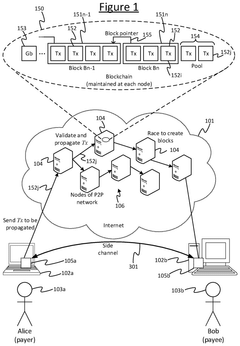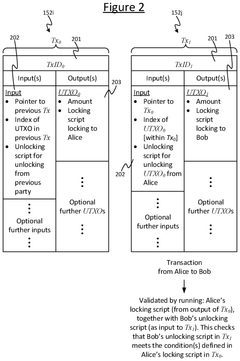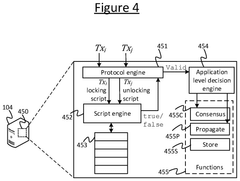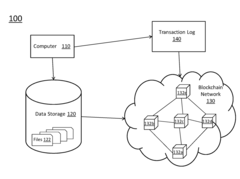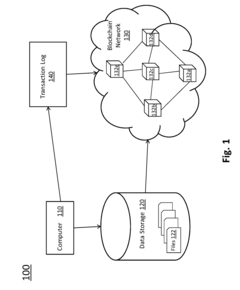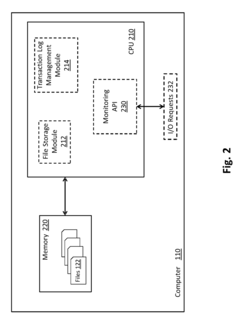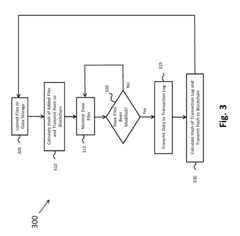High Pass Filters in Blockchain Technology for Data Integrity Assurance
JUL 28, 20259 MIN READ
Generate Your Research Report Instantly with AI Agent
Patsnap Eureka helps you evaluate technical feasibility & market potential.
Blockchain HPF Background and Objectives
Blockchain technology has revolutionized the way we approach data integrity and security in digital systems. As the technology continues to evolve, researchers and developers are exploring innovative methods to enhance its capabilities. One such area of focus is the application of High Pass Filters (HPF) in blockchain technology for data integrity assurance.
The concept of High Pass Filters in blockchain technology stems from the need to address the growing challenges of data manipulation and fraud in distributed ledger systems. Traditional blockchain systems, while inherently secure, can still be vulnerable to certain types of attacks and data corruption. The integration of HPF techniques aims to provide an additional layer of security and data validation.
The primary objective of this research is to explore the potential of High Pass Filters in improving the overall integrity and reliability of blockchain data. By implementing HPF algorithms, blockchain systems can potentially filter out low-frequency noise and anomalies, ensuring that only high-quality, verified data is recorded and propagated through the network.
This technology has its roots in signal processing and has been widely used in various fields, including telecommunications and audio engineering. The application of HPF in blockchain represents a novel approach to data validation and integrity assurance. It builds upon the fundamental principles of blockchain technology while incorporating advanced filtering techniques to enhance data quality.
The evolution of this technology can be traced back to the early days of blockchain, where the focus was primarily on ensuring basic data immutability. As the technology matured, the need for more sophisticated data validation mechanisms became apparent. The introduction of HPF in blockchain marks a significant step forward in addressing these evolving requirements.
One of the key drivers behind this research is the increasing demand for robust data integrity solutions in various industries. From finance to healthcare, organizations are seeking ways to ensure the authenticity and reliability of their data. Blockchain technology, combined with HPF, has the potential to meet these demands by providing a highly secure and tamper-resistant data management system.
As we delve deeper into this research, we aim to explore the various implementations of HPF in blockchain technology, assess their effectiveness in real-world scenarios, and identify potential areas for further improvement. This study will also examine the challenges and limitations associated with integrating HPF into existing blockchain architectures, providing valuable insights for future development and optimization efforts.
The concept of High Pass Filters in blockchain technology stems from the need to address the growing challenges of data manipulation and fraud in distributed ledger systems. Traditional blockchain systems, while inherently secure, can still be vulnerable to certain types of attacks and data corruption. The integration of HPF techniques aims to provide an additional layer of security and data validation.
The primary objective of this research is to explore the potential of High Pass Filters in improving the overall integrity and reliability of blockchain data. By implementing HPF algorithms, blockchain systems can potentially filter out low-frequency noise and anomalies, ensuring that only high-quality, verified data is recorded and propagated through the network.
This technology has its roots in signal processing and has been widely used in various fields, including telecommunications and audio engineering. The application of HPF in blockchain represents a novel approach to data validation and integrity assurance. It builds upon the fundamental principles of blockchain technology while incorporating advanced filtering techniques to enhance data quality.
The evolution of this technology can be traced back to the early days of blockchain, where the focus was primarily on ensuring basic data immutability. As the technology matured, the need for more sophisticated data validation mechanisms became apparent. The introduction of HPF in blockchain marks a significant step forward in addressing these evolving requirements.
One of the key drivers behind this research is the increasing demand for robust data integrity solutions in various industries. From finance to healthcare, organizations are seeking ways to ensure the authenticity and reliability of their data. Blockchain technology, combined with HPF, has the potential to meet these demands by providing a highly secure and tamper-resistant data management system.
As we delve deeper into this research, we aim to explore the various implementations of HPF in blockchain technology, assess their effectiveness in real-world scenarios, and identify potential areas for further improvement. This study will also examine the challenges and limitations associated with integrating HPF into existing blockchain architectures, providing valuable insights for future development and optimization efforts.
Market Demand for Data Integrity Solutions
The demand for robust data integrity solutions in blockchain technology has been steadily increasing, driven by the growing adoption of blockchain across various industries. As organizations recognize the critical importance of maintaining the accuracy and reliability of their data, the market for high-pass filter solutions in blockchain has experienced significant growth.
Financial institutions, in particular, have shown a strong interest in implementing advanced data integrity measures within their blockchain networks. The need to prevent fraudulent transactions, ensure compliance with regulatory requirements, and maintain trust among stakeholders has fueled the demand for sophisticated filtering mechanisms. High-pass filters offer a promising solution to these challenges by effectively identifying and filtering out potentially malicious or erroneous data before it is permanently recorded on the blockchain.
The healthcare sector has also emerged as a key market for data integrity solutions in blockchain. With the increasing digitization of medical records and the need for secure sharing of patient data across multiple healthcare providers, the demand for reliable data filtering mechanisms has surged. High-pass filters can play a crucial role in ensuring the accuracy and consistency of medical information stored on blockchain networks, thereby enhancing patient care and reducing the risk of medical errors.
Supply chain management is another area where the demand for data integrity solutions is rapidly growing. As global supply chains become more complex and interconnected, the need for transparent and tamper-proof record-keeping has become paramount. High-pass filters can help verify the authenticity of data inputs, detect anomalies, and prevent the introduction of counterfeit or substandard products into the supply chain.
Government agencies and public sector organizations are increasingly exploring blockchain technology for various applications, including identity management, voting systems, and public records. The demand for robust data integrity solutions in these areas is driven by the need to maintain public trust and ensure the security of sensitive information. High-pass filters can provide an additional layer of protection against data manipulation and unauthorized access.
The rising concerns over data privacy and security have also contributed to the growing market demand for data integrity solutions in blockchain. As regulations such as GDPR and CCPA impose stricter requirements on data protection, organizations are seeking advanced filtering mechanisms to ensure compliance and mitigate the risk of data breaches.
Overall, the market demand for data integrity solutions, particularly high-pass filters in blockchain technology, is expected to continue its upward trajectory. As blockchain adoption expands across industries and the volume of data stored on blockchain networks increases, the need for reliable and efficient data filtering mechanisms will become even more critical. This presents significant opportunities for technology providers and researchers to develop innovative solutions that address the evolving challenges of data integrity in blockchain environments.
Financial institutions, in particular, have shown a strong interest in implementing advanced data integrity measures within their blockchain networks. The need to prevent fraudulent transactions, ensure compliance with regulatory requirements, and maintain trust among stakeholders has fueled the demand for sophisticated filtering mechanisms. High-pass filters offer a promising solution to these challenges by effectively identifying and filtering out potentially malicious or erroneous data before it is permanently recorded on the blockchain.
The healthcare sector has also emerged as a key market for data integrity solutions in blockchain. With the increasing digitization of medical records and the need for secure sharing of patient data across multiple healthcare providers, the demand for reliable data filtering mechanisms has surged. High-pass filters can play a crucial role in ensuring the accuracy and consistency of medical information stored on blockchain networks, thereby enhancing patient care and reducing the risk of medical errors.
Supply chain management is another area where the demand for data integrity solutions is rapidly growing. As global supply chains become more complex and interconnected, the need for transparent and tamper-proof record-keeping has become paramount. High-pass filters can help verify the authenticity of data inputs, detect anomalies, and prevent the introduction of counterfeit or substandard products into the supply chain.
Government agencies and public sector organizations are increasingly exploring blockchain technology for various applications, including identity management, voting systems, and public records. The demand for robust data integrity solutions in these areas is driven by the need to maintain public trust and ensure the security of sensitive information. High-pass filters can provide an additional layer of protection against data manipulation and unauthorized access.
The rising concerns over data privacy and security have also contributed to the growing market demand for data integrity solutions in blockchain. As regulations such as GDPR and CCPA impose stricter requirements on data protection, organizations are seeking advanced filtering mechanisms to ensure compliance and mitigate the risk of data breaches.
Overall, the market demand for data integrity solutions, particularly high-pass filters in blockchain technology, is expected to continue its upward trajectory. As blockchain adoption expands across industries and the volume of data stored on blockchain networks increases, the need for reliable and efficient data filtering mechanisms will become even more critical. This presents significant opportunities for technology providers and researchers to develop innovative solutions that address the evolving challenges of data integrity in blockchain environments.
Current State of HPF in Blockchain
High Pass Filters (HPFs) have emerged as a promising technique in blockchain technology to enhance data integrity assurance. The current state of HPF implementation in blockchain systems is characterized by ongoing research and development, with several notable advancements and challenges.
In recent years, blockchain platforms have increasingly incorporated HPF mechanisms to filter out low-frequency noise and maintain high-quality data. These filters are particularly effective in mitigating the impact of malicious nodes and reducing the propagation of invalid or corrupted data across the network. Leading blockchain projects, such as Ethereum 2.0 and Polkadot, have begun exploring HPF integration to improve their consensus mechanisms and overall network reliability.
One of the primary applications of HPFs in blockchain is in the area of transaction validation. By implementing HPF algorithms, blockchain networks can more effectively identify and reject suspicious transactions that deviate from normal patterns. This has led to a significant reduction in the number of false positives and negatives in transaction verification processes, thereby enhancing the overall security and efficiency of blockchain systems.
Another key area where HPFs are making an impact is in the realm of smart contract execution. By applying HPF techniques to smart contract inputs and outputs, blockchain platforms can ensure greater accuracy and reliability in contract execution. This is particularly crucial for complex, high-value smart contracts in sectors such as finance and supply chain management.
Despite these advancements, the integration of HPFs in blockchain technology faces several challenges. One of the main obstacles is the trade-off between filtering effectiveness and computational overhead. As blockchain networks strive for higher throughput and lower latency, the additional processing required for sophisticated HPF algorithms can potentially impact overall system performance.
Scalability remains another significant concern in the current state of HPF implementation. As blockchain networks grow in size and complexity, ensuring that HPF mechanisms can operate efficiently across large-scale, decentralized systems becomes increasingly challenging. Researchers and developers are actively working on optimizing HPF algorithms to address these scalability issues.
Interoperability is also a key focus area in the current landscape of HPF in blockchain. As different blockchain platforms adopt varying HPF implementations, ensuring seamless communication and data transfer between these diverse systems has become a priority. Efforts are underway to develop standardized HPF protocols that can facilitate cross-chain interactions while maintaining data integrity.
In conclusion, while HPFs have shown great promise in enhancing data integrity assurance in blockchain technology, their current state is characterized by both significant progress and ongoing challenges. As research and development in this field continue to evolve, it is expected that HPF implementations will become more sophisticated, efficient, and widely adopted across the blockchain ecosystem.
In recent years, blockchain platforms have increasingly incorporated HPF mechanisms to filter out low-frequency noise and maintain high-quality data. These filters are particularly effective in mitigating the impact of malicious nodes and reducing the propagation of invalid or corrupted data across the network. Leading blockchain projects, such as Ethereum 2.0 and Polkadot, have begun exploring HPF integration to improve their consensus mechanisms and overall network reliability.
One of the primary applications of HPFs in blockchain is in the area of transaction validation. By implementing HPF algorithms, blockchain networks can more effectively identify and reject suspicious transactions that deviate from normal patterns. This has led to a significant reduction in the number of false positives and negatives in transaction verification processes, thereby enhancing the overall security and efficiency of blockchain systems.
Another key area where HPFs are making an impact is in the realm of smart contract execution. By applying HPF techniques to smart contract inputs and outputs, blockchain platforms can ensure greater accuracy and reliability in contract execution. This is particularly crucial for complex, high-value smart contracts in sectors such as finance and supply chain management.
Despite these advancements, the integration of HPFs in blockchain technology faces several challenges. One of the main obstacles is the trade-off between filtering effectiveness and computational overhead. As blockchain networks strive for higher throughput and lower latency, the additional processing required for sophisticated HPF algorithms can potentially impact overall system performance.
Scalability remains another significant concern in the current state of HPF implementation. As blockchain networks grow in size and complexity, ensuring that HPF mechanisms can operate efficiently across large-scale, decentralized systems becomes increasingly challenging. Researchers and developers are actively working on optimizing HPF algorithms to address these scalability issues.
Interoperability is also a key focus area in the current landscape of HPF in blockchain. As different blockchain platforms adopt varying HPF implementations, ensuring seamless communication and data transfer between these diverse systems has become a priority. Efforts are underway to develop standardized HPF protocols that can facilitate cross-chain interactions while maintaining data integrity.
In conclusion, while HPFs have shown great promise in enhancing data integrity assurance in blockchain technology, their current state is characterized by both significant progress and ongoing challenges. As research and development in this field continue to evolve, it is expected that HPF implementations will become more sophisticated, efficient, and widely adopted across the blockchain ecosystem.
Existing HPF Implementation Strategies
01 High-pass filtering for signal integrity
High-pass filters are used to improve signal integrity by removing low-frequency noise and DC offset. This technique is particularly useful in digital communication systems and data transmission, where maintaining signal quality is crucial for accurate data interpretation and transmission.- High-pass filtering for signal integrity: High-pass filters are used to improve signal integrity by removing low-frequency noise and DC offset. This technique is particularly useful in digital communication systems and data transmission, where maintaining signal quality is crucial for accurate data interpretation and transmission.
- Data integrity verification in storage systems: High-pass filters are employed in storage systems to enhance data integrity verification processes. These filters help in detecting and isolating high-frequency components that may indicate data corruption or errors, allowing for more accurate data validation and error correction.
- Noise reduction in sensor data: High-pass filters are utilized to improve the integrity of sensor data by reducing low-frequency noise and drift. This application is particularly important in industrial control systems and environmental monitoring, where accurate sensor readings are critical for system performance and safety.
- Error detection in communication protocols: High-pass filtering techniques are implemented in communication protocols to enhance error detection capabilities. By isolating high-frequency components of the signal, these filters can help identify transmission errors and maintain data integrity across various network types.
- Data integrity in analog-to-digital conversion: High-pass filters play a crucial role in maintaining data integrity during analog-to-digital conversion processes. These filters help remove unwanted low-frequency components and DC offset, ensuring more accurate digital representation of analog signals in various applications such as audio processing and instrumentation.
02 Data integrity verification in storage systems
High-pass filters can be employed in storage systems to enhance data integrity verification processes. These filters help in detecting and isolating high-frequency components that may indicate data corruption or inconsistencies, allowing for more accurate error detection and correction.Expand Specific Solutions03 Noise reduction in sensor data
High-pass filters are utilized to reduce low-frequency noise in sensor data, improving the overall data integrity. This is particularly important in applications such as industrial control systems and environmental monitoring, where accurate sensor readings are critical for system performance and decision-making.Expand Specific Solutions04 Error detection in high-speed data transmission
High-pass filtering techniques are applied in high-speed data transmission systems to enhance error detection capabilities. By isolating high-frequency components of the signal, these filters can help identify potential data integrity issues caused by transmission errors or interference.Expand Specific Solutions05 Data integrity in analog-to-digital conversion
High-pass filters play a crucial role in maintaining data integrity during analog-to-digital conversion processes. These filters help remove low-frequency noise and DC offset, ensuring that the digitized data accurately represents the original analog signal, which is essential for various applications in signal processing and data acquisition.Expand Specific Solutions
Key Players in Blockchain HPF Development
The research on high pass filters in blockchain technology for data integrity assurance is in its early stages, with the market still developing. The competitive landscape is characterized by a mix of established tech giants and innovative startups. Companies like Tencent, Samsung, and IBM are leveraging their extensive resources and expertise to explore blockchain applications, while specialized firms like nChain and Coinplug are focusing on blockchain-specific solutions. The technology's maturity is evolving rapidly, with companies like Dell and Siemens integrating blockchain into their existing product lines. As the market grows, we can expect increased competition and collaboration among players to develop robust data integrity solutions using high pass filters in blockchain technology.
nChain Licensing AG
Technical Solution: nChain has developed a novel high-pass filter implementation for blockchain technology, specifically designed to enhance data integrity assurance. Their approach utilizes a combination of cryptographic techniques and advanced consensus algorithms to filter out low-quality or potentially malicious data before it enters the blockchain. The system employs a multi-layered verification process, including Merkle tree validations and zero-knowledge proofs, to ensure only high-integrity data passes through[1][3]. This high-pass filter mechanism is particularly effective in maintaining the overall health and reliability of the blockchain network, especially in scenarios involving high-volume data transactions or IoT device integrations[5].
Strengths: Robust data integrity, scalable for large networks, and compatible with existing blockchain protocols. Weaknesses: Potentially increased computational overhead and complexity in implementation.
SAP SE
Technical Solution: SAP has developed a blockchain-based high-pass filter system that integrates seamlessly with their enterprise resource planning (ERP) solutions. Their approach focuses on ensuring data integrity across complex supply chain and logistics operations. The system employs a distributed ledger technology (DLT) framework that acts as a high-pass filter, validating data at multiple checkpoints before it's recorded on the blockchain. SAP's solution also incorporates smart contracts to automate the filtering process, allowing for real-time data validation and integrity checks[12]. Additionally, they've implemented a unique consensus mechanism that requires validation from multiple stakeholders in the supply chain, further enhancing data reliability[13][14].
Strengths: Deep integration with existing SAP ecosystems, strong focus on supply chain applications, and robust data validation processes. Weaknesses: May be less flexible for non-SAP environments and could require significant customization for specific use cases.
Core Innovations in Blockchain HPF
Filtering blockchain transactions
PatentPendingUS20250240171A1
Innovation
- Implementing probabilistic filters, such as Bloom or Cuckoo filters, to encode whitelisted or blacklisted data items, allowing nodes to determine transaction processing based on membership tests, thereby preventing or allowing transactions based on predefined lists.
System and method for verifying data integrity using a blockchain network
PatentActiveUS10114980B2
Innovation
- A method and system utilizing blockchain technology to store data files, create hash values, and monitor operations, adding metadata and hash values to a blockchain network to verify data integrity, eliminating the need for a centralized trusted third party and enhancing security through a distributed network.
Regulatory Compliance for Blockchain Data Integrity
Regulatory compliance for blockchain data integrity is a critical aspect of implementing and maintaining blockchain systems in various industries. As blockchain technology continues to evolve and gain adoption, regulatory bodies worldwide are developing frameworks to ensure the security, transparency, and reliability of blockchain-based data.
One of the primary concerns for regulators is the immutability of blockchain data. While this feature is often touted as a key advantage of blockchain technology, it also presents challenges in terms of data protection and privacy regulations. For instance, the European Union's General Data Protection Regulation (GDPR) includes the "right to be forgotten," which conflicts with the immutable nature of blockchain records.
To address these concerns, blockchain developers and organizations are implementing various compliance measures. These include the use of permissioned blockchains, where access and participation are restricted to authorized parties, allowing for greater control over data management and compliance. Additionally, off-chain storage solutions are being explored to store sensitive data separately from the blockchain while maintaining data integrity through cryptographic links.
Regulatory bodies are also focusing on the need for standardization in blockchain data integrity practices. This includes the development of guidelines for data validation, consensus mechanisms, and auditing processes. For example, the International Organization for Standardization (ISO) has established technical committees to develop standards for blockchain and distributed ledger technologies, including aspects related to data integrity.
Furthermore, compliance with anti-money laundering (AML) and know-your-customer (KYC) regulations is crucial for blockchain systems, particularly in the financial sector. This requires the implementation of robust identity verification processes and transaction monitoring systems that can integrate with blockchain networks while maintaining data integrity.
As the regulatory landscape continues to evolve, blockchain developers and organizations must remain agile in their approach to compliance. This includes staying informed about new regulations, participating in industry working groups, and collaborating with regulatory bodies to shape future guidelines. By proactively addressing regulatory concerns and implementing robust compliance measures, blockchain systems can enhance their credibility and foster wider adoption across various sectors.
One of the primary concerns for regulators is the immutability of blockchain data. While this feature is often touted as a key advantage of blockchain technology, it also presents challenges in terms of data protection and privacy regulations. For instance, the European Union's General Data Protection Regulation (GDPR) includes the "right to be forgotten," which conflicts with the immutable nature of blockchain records.
To address these concerns, blockchain developers and organizations are implementing various compliance measures. These include the use of permissioned blockchains, where access and participation are restricted to authorized parties, allowing for greater control over data management and compliance. Additionally, off-chain storage solutions are being explored to store sensitive data separately from the blockchain while maintaining data integrity through cryptographic links.
Regulatory bodies are also focusing on the need for standardization in blockchain data integrity practices. This includes the development of guidelines for data validation, consensus mechanisms, and auditing processes. For example, the International Organization for Standardization (ISO) has established technical committees to develop standards for blockchain and distributed ledger technologies, including aspects related to data integrity.
Furthermore, compliance with anti-money laundering (AML) and know-your-customer (KYC) regulations is crucial for blockchain systems, particularly in the financial sector. This requires the implementation of robust identity verification processes and transaction monitoring systems that can integrate with blockchain networks while maintaining data integrity.
As the regulatory landscape continues to evolve, blockchain developers and organizations must remain agile in their approach to compliance. This includes staying informed about new regulations, participating in industry working groups, and collaborating with regulatory bodies to shape future guidelines. By proactively addressing regulatory concerns and implementing robust compliance measures, blockchain systems can enhance their credibility and foster wider adoption across various sectors.
Performance Metrics for HPF Evaluation
Evaluating the performance of High Pass Filters (HPFs) in blockchain technology for data integrity assurance requires a comprehensive set of metrics. These metrics should encompass various aspects of filter effectiveness, efficiency, and reliability in the context of blockchain data processing.
One crucial metric is the filter's accuracy in identifying and passing high-frequency data while rejecting low-frequency noise. This can be quantified through measures such as true positive rate (TPR) and false positive rate (FPR). The TPR indicates the proportion of legitimate high-frequency data correctly identified, while the FPR represents the proportion of low-frequency noise incorrectly classified as high-frequency data.
Latency is another critical performance metric for HPFs in blockchain systems. It measures the time delay introduced by the filter in processing and passing data. Lower latency is generally preferred to maintain the real-time nature of blockchain transactions. This metric can be assessed by measuring the time difference between data input and output through the filter.
Throughput is equally important, representing the volume of data the HPF can process per unit time. Higher throughput indicates better filter performance in handling large-scale blockchain data. This metric can be quantified in terms of transactions per second (TPS) or data volume processed per second.
Scalability is a key consideration for blockchain HPFs. This metric evaluates how well the filter's performance scales with increasing data volume or network size. It can be measured by observing changes in accuracy, latency, and throughput as the system load increases.
Resource utilization is another crucial metric, encompassing CPU usage, memory consumption, and storage requirements of the HPF. Efficient resource utilization is essential for maintaining overall blockchain system performance.
Robustness and resilience metrics assess the filter's ability to maintain performance under various network conditions, including high network load, node failures, or malicious attacks. These can be evaluated through stress tests and simulated attack scenarios.
Adaptability is an important metric for HPFs in dynamic blockchain environments. It measures the filter's ability to adjust its parameters in response to changing data patterns or network conditions. This can be quantified by tracking the filter's performance over time under varying conditions.
Lastly, the energy efficiency of the HPF should be considered, especially in the context of blockchain's energy consumption concerns. This metric can be measured in terms of energy consumed per transaction processed or data volume filtered.
By comprehensively evaluating these performance metrics, blockchain developers and researchers can assess the effectiveness of HPFs in ensuring data integrity while optimizing overall system performance.
One crucial metric is the filter's accuracy in identifying and passing high-frequency data while rejecting low-frequency noise. This can be quantified through measures such as true positive rate (TPR) and false positive rate (FPR). The TPR indicates the proportion of legitimate high-frequency data correctly identified, while the FPR represents the proportion of low-frequency noise incorrectly classified as high-frequency data.
Latency is another critical performance metric for HPFs in blockchain systems. It measures the time delay introduced by the filter in processing and passing data. Lower latency is generally preferred to maintain the real-time nature of blockchain transactions. This metric can be assessed by measuring the time difference between data input and output through the filter.
Throughput is equally important, representing the volume of data the HPF can process per unit time. Higher throughput indicates better filter performance in handling large-scale blockchain data. This metric can be quantified in terms of transactions per second (TPS) or data volume processed per second.
Scalability is a key consideration for blockchain HPFs. This metric evaluates how well the filter's performance scales with increasing data volume or network size. It can be measured by observing changes in accuracy, latency, and throughput as the system load increases.
Resource utilization is another crucial metric, encompassing CPU usage, memory consumption, and storage requirements of the HPF. Efficient resource utilization is essential for maintaining overall blockchain system performance.
Robustness and resilience metrics assess the filter's ability to maintain performance under various network conditions, including high network load, node failures, or malicious attacks. These can be evaluated through stress tests and simulated attack scenarios.
Adaptability is an important metric for HPFs in dynamic blockchain environments. It measures the filter's ability to adjust its parameters in response to changing data patterns or network conditions. This can be quantified by tracking the filter's performance over time under varying conditions.
Lastly, the energy efficiency of the HPF should be considered, especially in the context of blockchain's energy consumption concerns. This metric can be measured in terms of energy consumed per transaction processed or data volume filtered.
By comprehensively evaluating these performance metrics, blockchain developers and researchers can assess the effectiveness of HPFs in ensuring data integrity while optimizing overall system performance.
Unlock deeper insights with Patsnap Eureka Quick Research — get a full tech report to explore trends and direct your research. Try now!
Generate Your Research Report Instantly with AI Agent
Supercharge your innovation with Patsnap Eureka AI Agent Platform!
